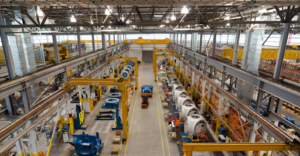Safety is always a top priority, no matter where you are. Whether you’re walking down the street or sitting at your desk at work, the need for safety is ever-present.
Imagine a manufacturing facility: machines whirring and the hum of the production line playing on repeat in your head. There’s some chatter here and there, but mostly, the machines dominate the noise in the facility.

Source: Global Trade Magazine
When you picture those machines, some are big and bulky, while others are small and slim. They’re likely operating near employees, who are busy with their tasks. All these elements make up the plant floor, and as long as tasks are being completed, production keeps running smoothly.
But, mistakes happen. Maybe an employee accidentally bumped into the machine, or maybe there was a programming error in the machine. Both of these scenarios will slow production down and increase the risk of injury or danger to employees nearby.
To reduce this risk, and ensure safety in the workplace, manufacturing facilities have incorporated machine safety measures. Not only does machine safety decrease potential harm to machines and employees, but it can also enhance production efficiency by minimizing the likelihood of downtime events due to safety incident mistakes.
At HESCO, we guide machine safety and recommend following the machine safety lifecycle to protect employees and equipment. Let’s dive into what the machine safety lifecycle is and how it affects your facility.
What is Machine Safety?
Before we dive into the machine safety lifecycle and how it can apply to your facility, let’s walk through what machine safety is.
Machine safety identifies and evaluates potential hazards from various energy sources (electrical, mechanical, pneumatic; etc) in a machine to assess the likelihood of occurrence and severity of harm. These safety measures aim to reduce the potential danger to both the machines and the employees.
Implementing machine safety measures can vary for each facility due to the different machines and potential risks involved. So, performing a Safety Assessment is the first step in the safety lifecycle to help what safety equipment is needed to maximize safety in your facility.
The Machine Safety Lifecycle: 5 Steps
Now that we understand the importance of machine safety, let’s explore the machine safety lifecycle in detail.
Imagine you are the Operations Manager at a facility that manufactures golf balls. You’ve recently purchased some new automation equipment, and the need for machine safety has become apparent due to some close calls with operators almost becoming injured.
Ensuring the safety of your employees by implementing machine safety measures brings you closer to a safer work environment. After contacting a company that performs safety assessments following the modernization of your facility, you are informed there is a machine safety lifecycle with 5 steps:
- Assessment
- Safety Functional Requirements Specification (SFRS)
- Design & Verification
- Installation & Validation
- Maintain & Improve
By completing these 5 steps, you can effectively evaluate and implement the necessary equipment to ensure a safe work environment for your employees. You decide to begin the process!

Source: Rockwell Automation
Step 1: Assessment
The first step of the machine safety lifecycle is the assessment portion. This is a critical step because it identifies areas where your employees could get hurt or machines could be damaged. You provide information on what machines you want to assess and the company helps to determine which assessment is right for you:
- Conformity Audit: A quick, high-level review to rank which machines pose the highest risk to a safety event.
- Standard Risk Assessment: A deeper dive into each machine, spending more time to specifically identify and document risks.
- Team-Based Risk Assessment: Similar to the standard assessment but involves a cross-functional team from the customer, aiming to teach the team how to perform the assessments on their own.
After reviewing your needs, the standard risk assessment is best for your facility. You schedule a day for the team to come and assess around 10 machines to ensure all safety measures are taken.
Step 2: Safety Functional Requirements Specification (SFRS)
After the assessment was performed, there were some hazards identified. The team that performed the assessment, alongside the safety engineer, takes the findings and talks to you to determine what your acceptable level of risk is, combining the likelihood of occurrence and severity of the incident. Then, you work together to determine production goals so they can determine the correct products that will reduce risk at or below your desired levels while staying above the production goal.
Since you are making safety your top priority, you move forward with the products they have recommended.
Step 3: Design & Verification
Now, it’s time to design! Since the team made some general hardware recommendations to you during the SFRS, they go one step further and make specific part recommendations. The deliverable is something that can be taken to any System Integrator or even used if you have the expertise in-house. Safety is your top priority during this project, so you opt for higher-quality, longer-lasting brands.
The team works with you to pick the exact models needed to mitigate the risks that were identified.
Step 4: Installation & Validation
You decided to move forward with the installation, so the team ordered the exact parts needed and coordinated the installation with you. The main goal is to ensure that the safety equipment to be installed is effectively reducing the risk to acceptable levels.
Validation confirms that the installed equipment addresses the risks identified in the assessment and does not impede production. The hard work is done!
Step 5: Maintain & Improve
Though the hard work is done, this is a continuous cycle. Ensuring safety in your workplace is crucial – in the future, the safety measures you just implemented may not be applicable. So, it is important to get reassessed and revalidated to safety standards and make the improvements as necessary.
By completing all five steps, your facility is now safer, experiencing less downtime due to safety events, ensuring employee safety, and mitigating risks through the machine safety lifecycle.
Challenges of the Machine Safety Lifecycle
Like any process, the machine safety lifecycle can face challenges, primarily due to user error. Some customers may invest in the initial assessment but fail to follow through with the following steps, leaving risks unmitigated and potentially creating legal liabilities if injuries occur.
It’s essential to complete the entire lifecycle to ensure your facility meets safety standards and minimizes risks effectively.
How HESCO and Rockwell Are Involved in Machine Safety
At HESCO, we provide information on the importance of machine safety and how the machine safety lifecycle is essential to ensuring a safe, productive environment for your employees to work in.
Rockwell Automation, our partner, offers services to perform assessments and provide guidance on mitigating risks. While they are one of the providers we distribute and recommend, it’s important to find the right fit for your needs.
Even if you are just looking for advice on how to get started, get in touch with us today. Taking the first step is crucial—machine safety is essential!
